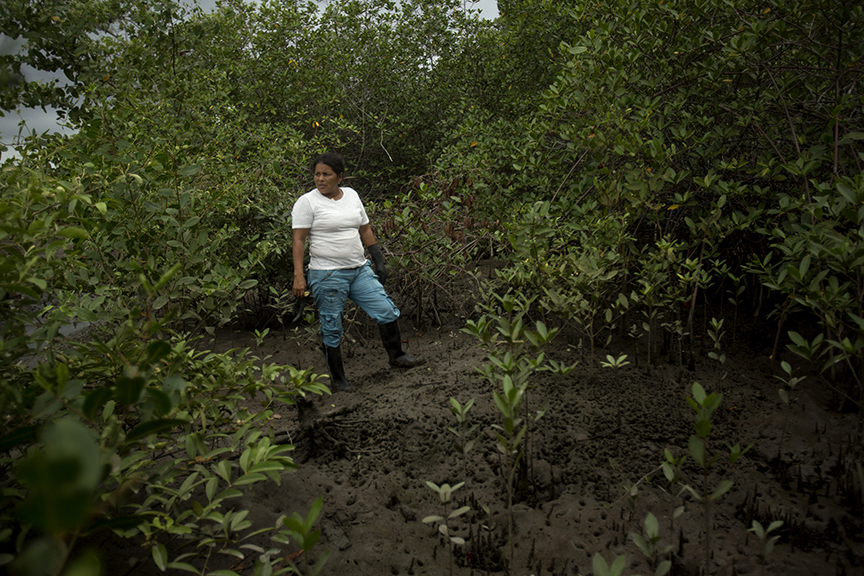As we saw in post 2, to produce food, natural resources (air, water, soil, biodiversity) and energy are needed. Food production is just one of the many human activities that have an impact on the planet’s limited resources.
Regarding food, are we consuming more that the earth produces? Is there enough food to feed everyone?
Today we produce food to feed 10 billion people1 for a planet which is currently home to around 7.7 billion.2 No wonder every year we waste ca. 1/3 of the food produced (post 3)) and 1.9 billion people are overweight!3. And still, there are 821 million undernourished people!4
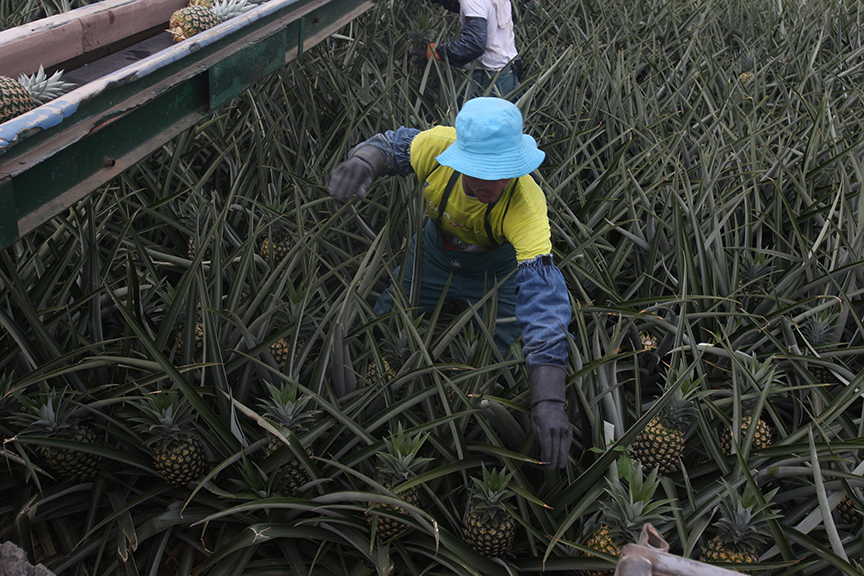
To understand why this happens, it is important to learn about two concepts which are key for sustainability: Biocapacity and Ecological Footprint.
Biological capacity
Earths Biocapacity is a quantitative way of measuring the natural resources that the earth produces each year (in global hectares or gha) to allow human life (clean water and air, biodiversity, healthy soils, shelter and medicines).5,6,7
It refers to the amount of productive area that is available to generate natural resources and to absorb the waste (ecosystem services).5-7.
The calculated Biocapacity for year 2007 was 1.8 gha.5-7
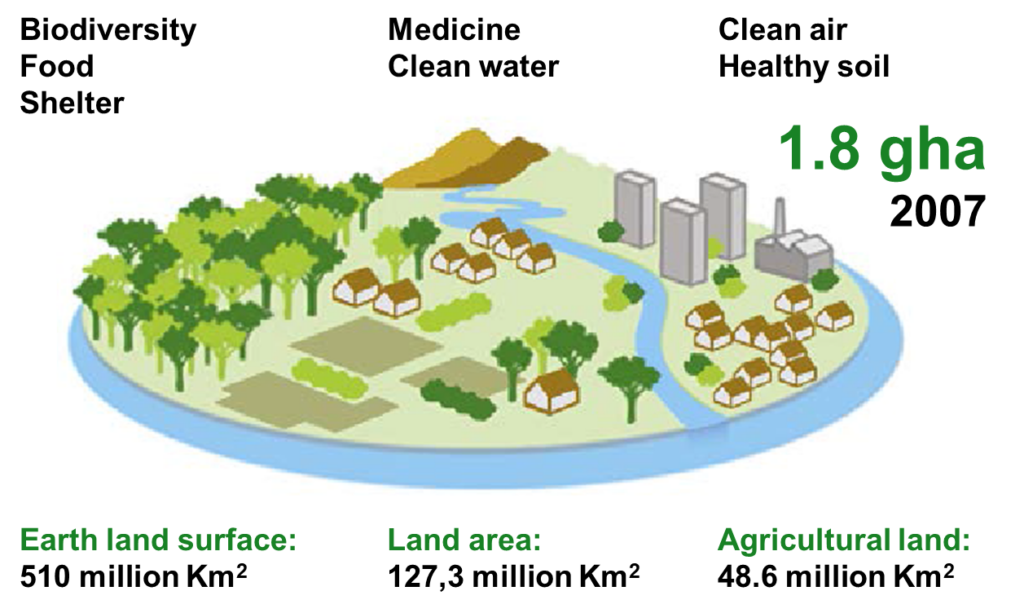
Ecological Footprint
The Human Ecological Footprint is a quantitative way of measuring the demand that human activity puts on nature. It refers to the consumption of productive land (resources in gha) of each person (biologically productive land and water area required to produce all the resources an individual, population, or activity consumes, and to absorb the waste they generate).5-7
The calculated world average Ecological Footprint for year 2007 was 2.7 gha.5-7
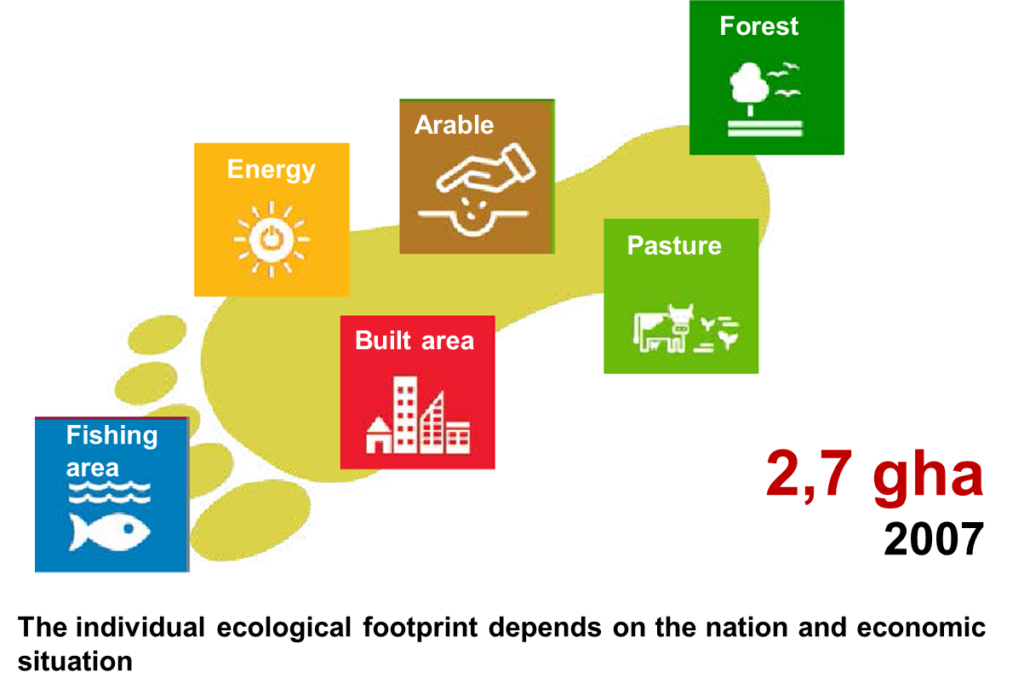
At the individual level, the Ecological Footprint refers to: the food we eat (energy, land, water, biodiversity), the water we use and the energy we consume (at home, to move around, to work, to live!).
Biocapacity, Ecological Footprint and Population
From the numbers above, it becomes evident that in 2007, our global consumption (Ecological Footprint: 2.7 gha) is much higher than the earth’s capacity to recover (Biocapacity: 1.8 gha).
To live sustainably, our Ecological Footprint (that of all humanity) should never exceed the Biocapacity of the earth.
The figure below shows the Ecological footprint and Biocapacity from 1960 to 2010 and the population growth up until 2019.
In 2007, humanity used resources equivalent to one and a half planets. If the trend continues, by 2050, 2 planets will be needed.5-7
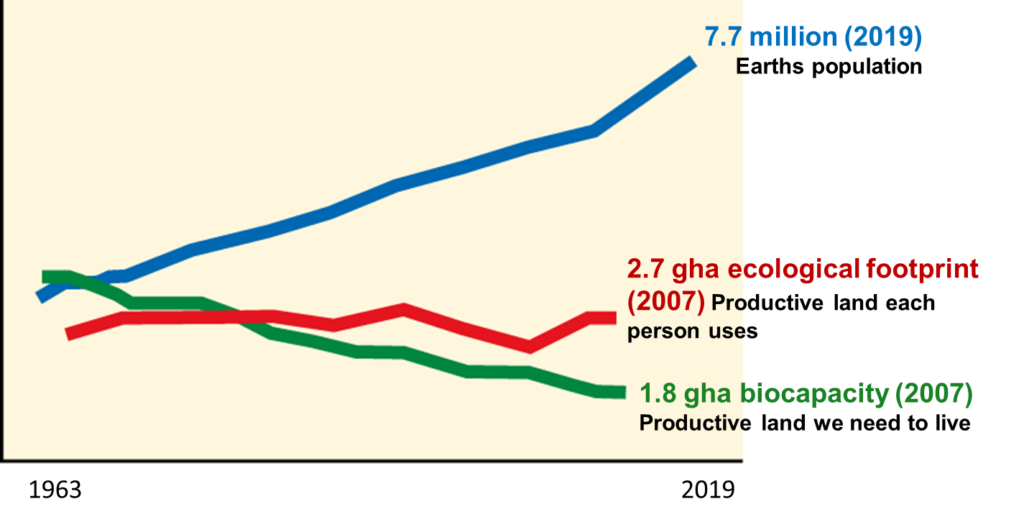
Source: Living Planet Report; The World Bank Data
Humanity is already using more resources than the earth can regenerate. This is known as overshoot, and each year this occurs, the biological debt increases with extreme consequences such as the loss of diversity (biological and cultural), migration and climate change. And the population keeps growing…
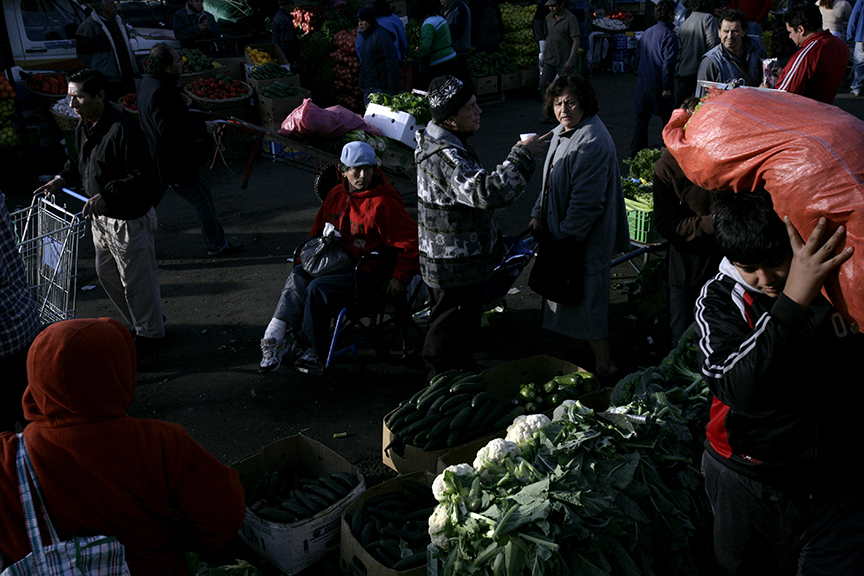
Are we all using resources in the same way?
Well, the Biocapacity and the Ecological Footprint are not the same for all people in all nations. The Global Footprint Network provides online data clearly showing the situation of all countries in the world. Let’s take, as an example, the year 2016. In 2016, the Biocapacity and Ecological Footprint in the United States were 3.6 and 8.1 gha (-4.5, deficit), in Italy 0.9 and 4.4 gha (-3.5, deficit), in China 1.0 and 3.6 gha (-2.6, deficit), in Brazil 8.7 and 2.8 gha (+5.9, reserve), and in Gabon 22.1 and 2.3 gha (+19.8, reserve).
This means that from these 5 countries, only Gabon and Brazil would have natural reserves to consume what they do and more. However, in a global scale, Gabon and Brazil are unwillingly using their resources to maintain the lifestyles of overconsumption of USA, Italy and China.
In 2007, the 5 countries with the highest Ecological Footprint were: United Arab Emirates, Qatar, Denmark, Belgium and United States, while the countries with the highest Biocapacity were: Gabon, Bolivia, Mongolia, Canada and Australia.7
Learn more about the global situation and find out about the situation in your own country using the interactive online platform of the Global Footprint Network. It’s really worth checking out!
With all this information, it seems that Ecological Footprint is related to human wellbeing, wouldn’t you agree?
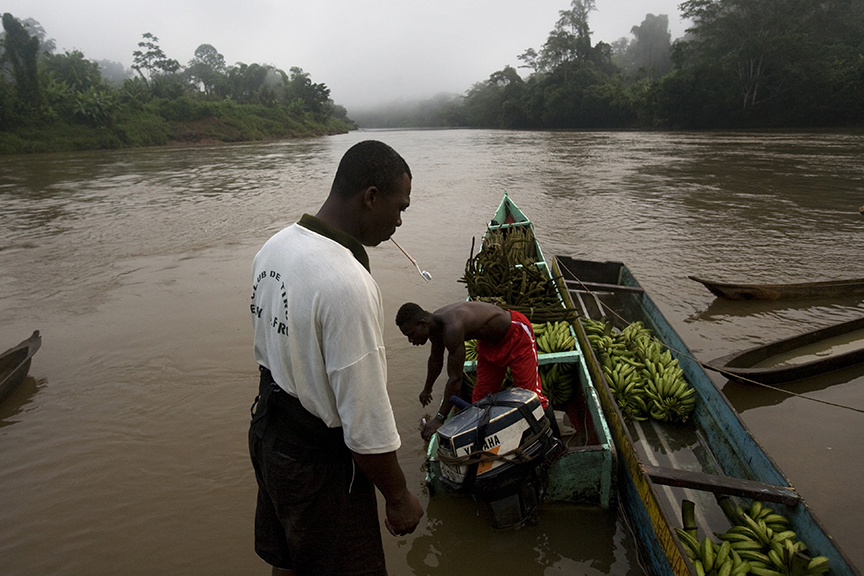
Human Development and the Ecological Footprint:
Human Development can be ranked using the Human Development Index (HDI). The HDI is a number calculated based on life expectancy, education and per capita income of a person in a country.
The United Nation Development Program defines a high level of development with HDI scores of 0.8 or greater.7
Considering again the data from 2007, in an ideal economic, social and environmental planet, all countries should have a HDI equal or higher to 0.8 and an Environmental Footprint that would not exceed 1.8 gha (or the earths biocapacity).7
No country on earth meets both conditions.
Interestingly, low-income countries which have abundant natural resources (high Biocapacity) have too small Ecological Footprints to meet the basic needs of food, shelter, health and sanitation of their populations.
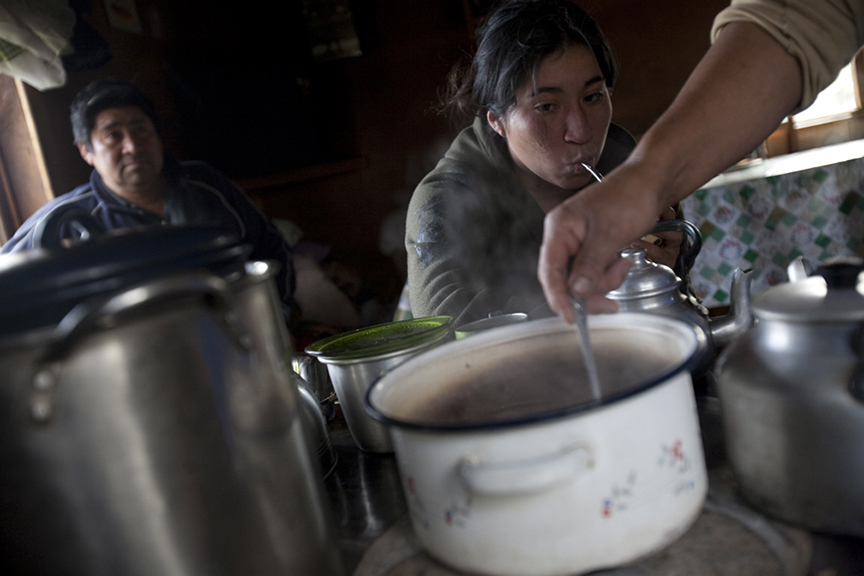
Humanity faces two big challenges:
- for highly developed countries, to maintain peoples well-being reducing the demand on nature and
- for developing nations, to guarantee the well-being of society without increasing Ecological Footprints.
Every person on the planet has the right to live better. However, the well-being of human societies depends of biological capital (Biocapacity) and therefore, human comforts (security, material needs, health, social relations, etc.). We must consider effective long-term resource management in order to address and reverse ecological degradation.7
To delve deeper into this topic, we recommend that you read our post that talks about Environmental Justice.
But, how can we explain that resources from low-income biologically-rich countries are being used to satisfy other countries’ demands? Is this land grabbing?
Land grabbing
Land grabbing is a process (usually violent) in which fertile agricultural land is privatized, usually for food corporation and mining companies. The GRAIN organization alerts that this global land grab could represent the end of small-scale farming, and rural livelihoods, in many places around the world.8
Using the data of GRAIN, Baveye et al., have published a map of the worlds land grab in 2008 which shows that China, South Korea, Saudi Arabia, United Arab Emirates and other countries own vast amounts of land abroad. For example, China in 2008 owned ca. 2 million hectares distributed in Philippines, Laos, Australia, Russia, Kazakhstan, Cameroon, Uganda and Tanzania.9
It would be useful to see what is going on today. To learn more about this argument, check out the publications from GRAIN. They are well worth a read!
If the land no longer belongs to the people living there, or even the country, what happens with the rights of those people and with their well-being? What happens with the land and the ecological services nature provides?
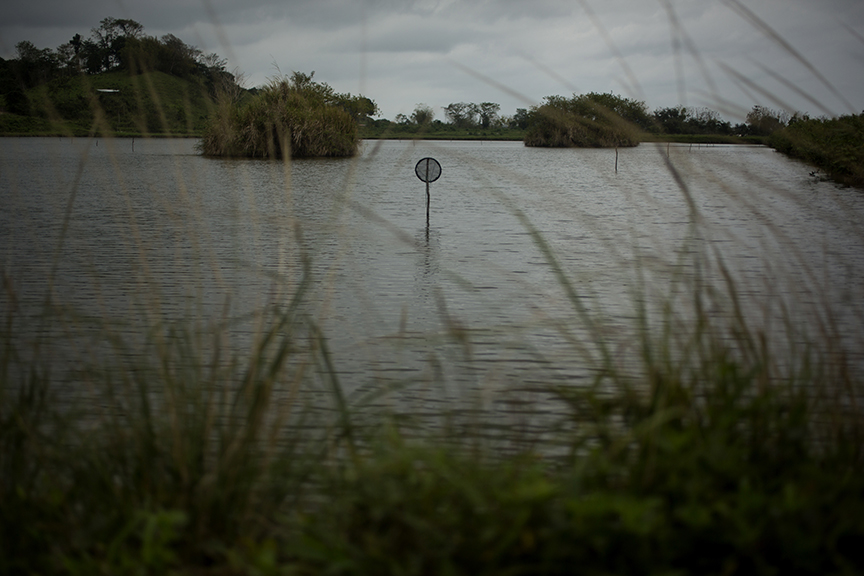
Human well-being and natural resource
Human well-being depends on biodiversity (species richness and rarity, biomass density, primary productivity and genetic diversity) and the services that a healthy ecosystem provides (food, water, fiber, medicine, energy, spiritual, ethic, climate regulation, energy and matter exchange, etc.). 7
All human economic activity depends on nature. It’s estimated that, globally, nature provides services worth around US$125 trillion a year.6
Unluckily, biological diversity is being lost. For example, the loss of animal diversity, measured using Living Planet Index between 1970 and 2014, shows that the overall species population of vertebrates has declined 60% (89% loss in South and Central America). The loss of fresh water species was 89%.6
For more information on endangered species, have a look the website of the IUCN Red List, which is a critical indicator of the health of the world’s biodiversity.
A healthy planet has enabled development of modern human society. Would it be possible to continue human development without healthy natural systems (biodiversity)?
The answer depends on us and on our capacity to change, adapt and create!
We are the first generation that has a clearer picture of the value of nature and the enormous impact we have on it.6
And why not begin with the understanding of our own personal situation!
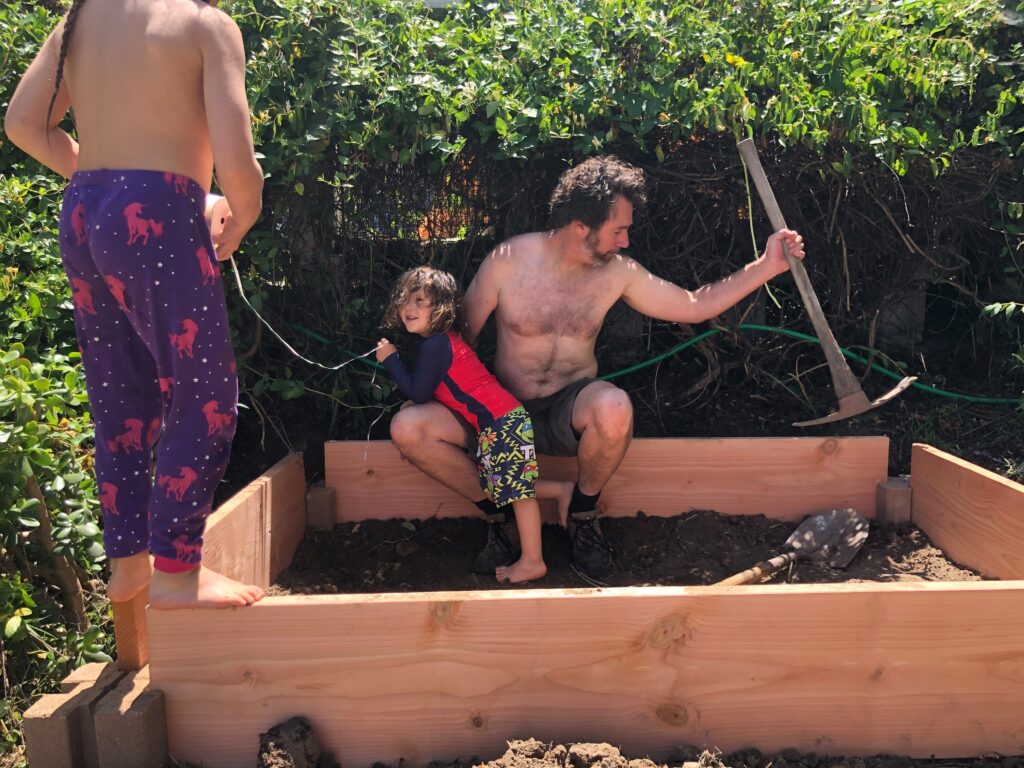
Personal Ecological Footprint
The Ecological Footprint is different for every person. It is related to individual actions. Even within a nation, the Ecological Footprint is not the same for all.
People that buy food from abroad and travel a lot by car and plane have a higher Environmental Footprint than people consuming locally produce food, preferring moving by bike/public transport/walking and rarely flying.
There are online platforms that help to calculate our personal Ecological Footprint. However, we recommend that you search for a local platform within your city or country as they might include local parameters (energy, water, transportation and waste). Give it a try!!
Let’s calculate our personal Ecological Footprint together
We found a very interesting study from Legambiente, an environmental Italian association, analysing the ecological footprint of the city of Padua.10 This study provides a Table for a first calculation of the personal ecological footprint in a month in area (hectares, ha) from kilograms (Kg) of food consumed, kilowatts (KWh) of energy used at home and kilometres used in transport (Km).
We have reproduced the excel sheet from this study (download here). If you wish to help us, please download the sheet and send the completed version with your personal results via email ([email protected]) sharing with us your name and country from where you are sending it. If we reach a significant number, we will share the results in a post!
This global problem is not new. In 2015, 193 countries belonging the United Nations countries, together with 150 leaders around the world, have agreed upon 17 sustainable development goals (SDGs) to be met by year 2030. These goals aim to end poverty, protect the planet and ensure prosperity for all.11
Sustainable Development Goals
As shown in the figure bellow, the 17 goals put at the base, the importance of protecting nature to build a healthy society that will support a fair economy.
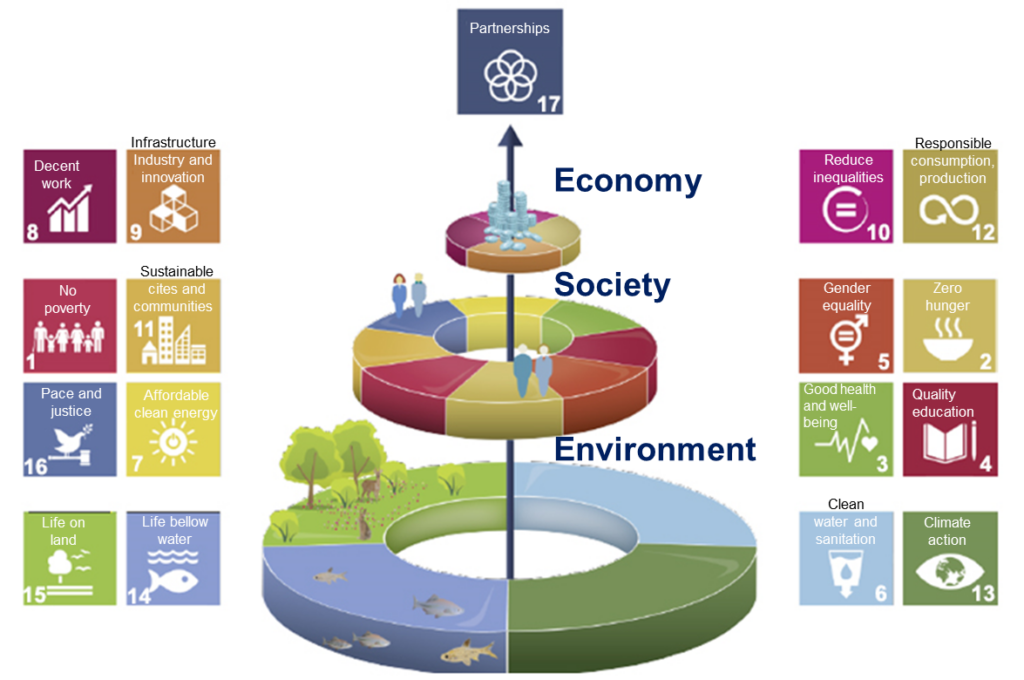
If we work together to achieve these goals, things will start to improve. Let’s give it a try!!
Importantly, all of these goals can be achieved by improving the food system. Food can be a good starting point to make changes. We all eat and our food choices have a direct impact on economy, society and the environment.
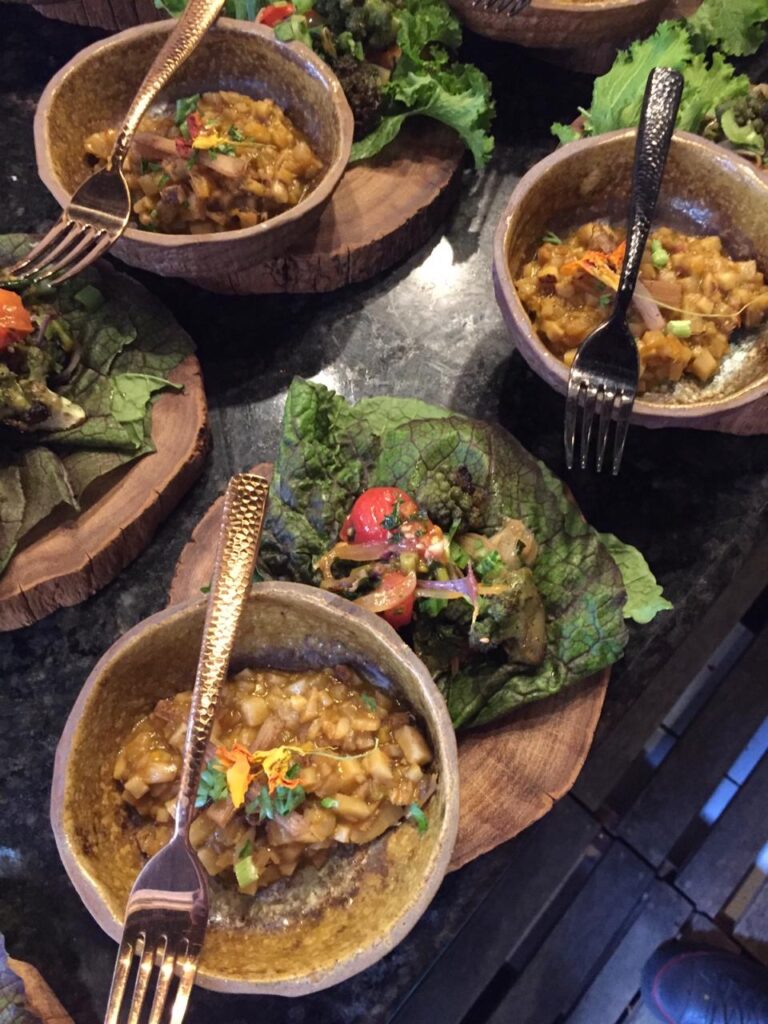
To better understand the impact of food on sustainability, the Barilla Center for Food and Nutrition has created a Food Sustainability Index. Data from 67 countries regarding food loss and waste, sustainable agriculture and nutritional challenges were analyzed and scored. The top 3 performing countries having policies and showing best practices in 2018 were France, the Netherlands and Canada. It is possible to check out the results and the scores of the participating countries – maybe yours is on the list!
BBC Mundo has published a very interesting article regarding this topic which includes an online calculator showing the environmental impact of 34 common foods and beverages. They remark that the Ecological Footprint depends not only on the food, but also specifically how and where it was produced. This is really worth checking out!
Conclusions:
Human well-being will not be possible without preserving nature (ecological resources and services) which sustain economy and life.
However, as natural resources become scarcer than money, prosperity will depend on resource accounts (biocapacity) as much as it depends on Gross Domestic Product (GDP) and other financial values.
A new way of thinking and revaluing nature (healthy ecosystems) and the services they provide should be considered. It is amazing how many new business opportunities are being created valuing all resources of the ecosystem and being respectful with nature and with people.
And of course, now that you know all of these things, try to make an effort to more thoughtfully choose what you eat, how you move and how much energy and water you use. Our interest, creativity and willingness to make little changes can and will improve things. Let’s give it a try:)
By M. S. Gachet.
REFERENCES:
1 Holt-Giménez E., et al. 2012. We Already Grow Enough Food for 10 Billion People … and Still Can’t End Hunger
2 Data World Bank. Population
3 WHO. Obesity and overweight
4 UN. Food
5 WWF. 2018. Living Planet Report 2018 (Full report)
6 WWF. 2018. Living Planet Report 2018 (Summery)
7 Global Footprint Network 2010. Ecological Footprint Atlas 2010
8 GRAIN. 2008. Seize: The 2008 land grab for food and financial security
9 Baveye, P.C., et al. 2011. From Dust Bowl to Dust Bowl: Soils are Still Very Much a Frontier of Science
10 Legamabiente. The Ecological Footprint of the city of Padua
11 UN. Sustainable Development Goals

